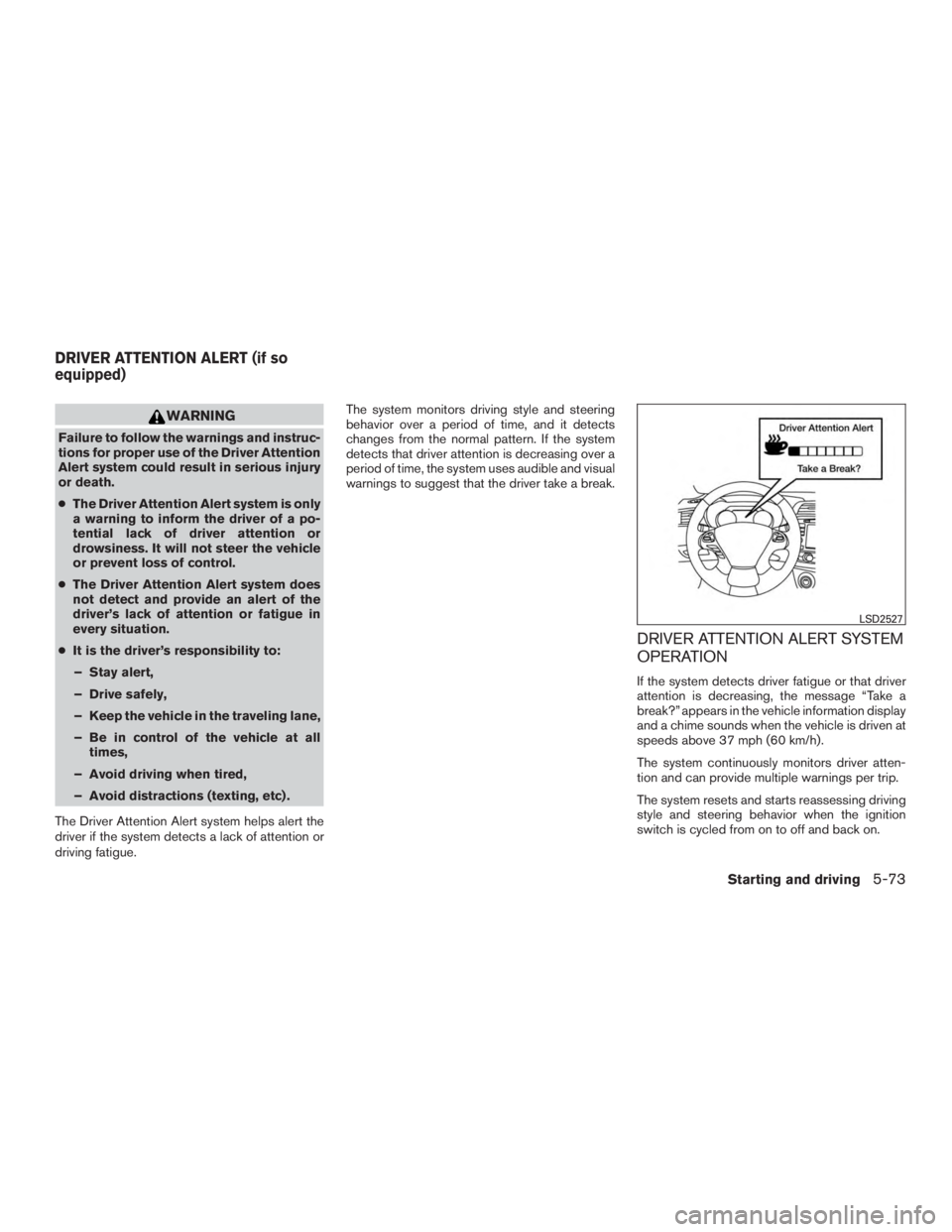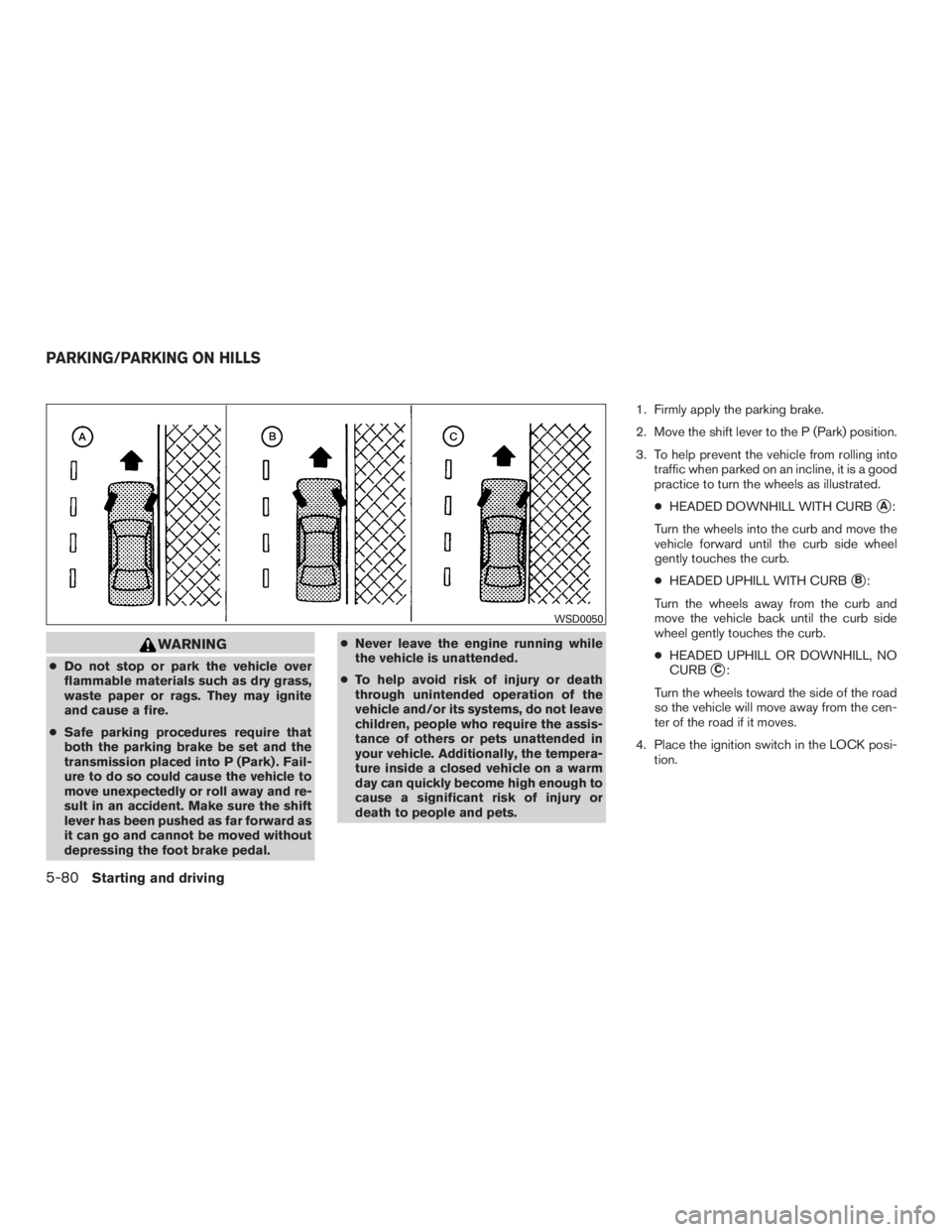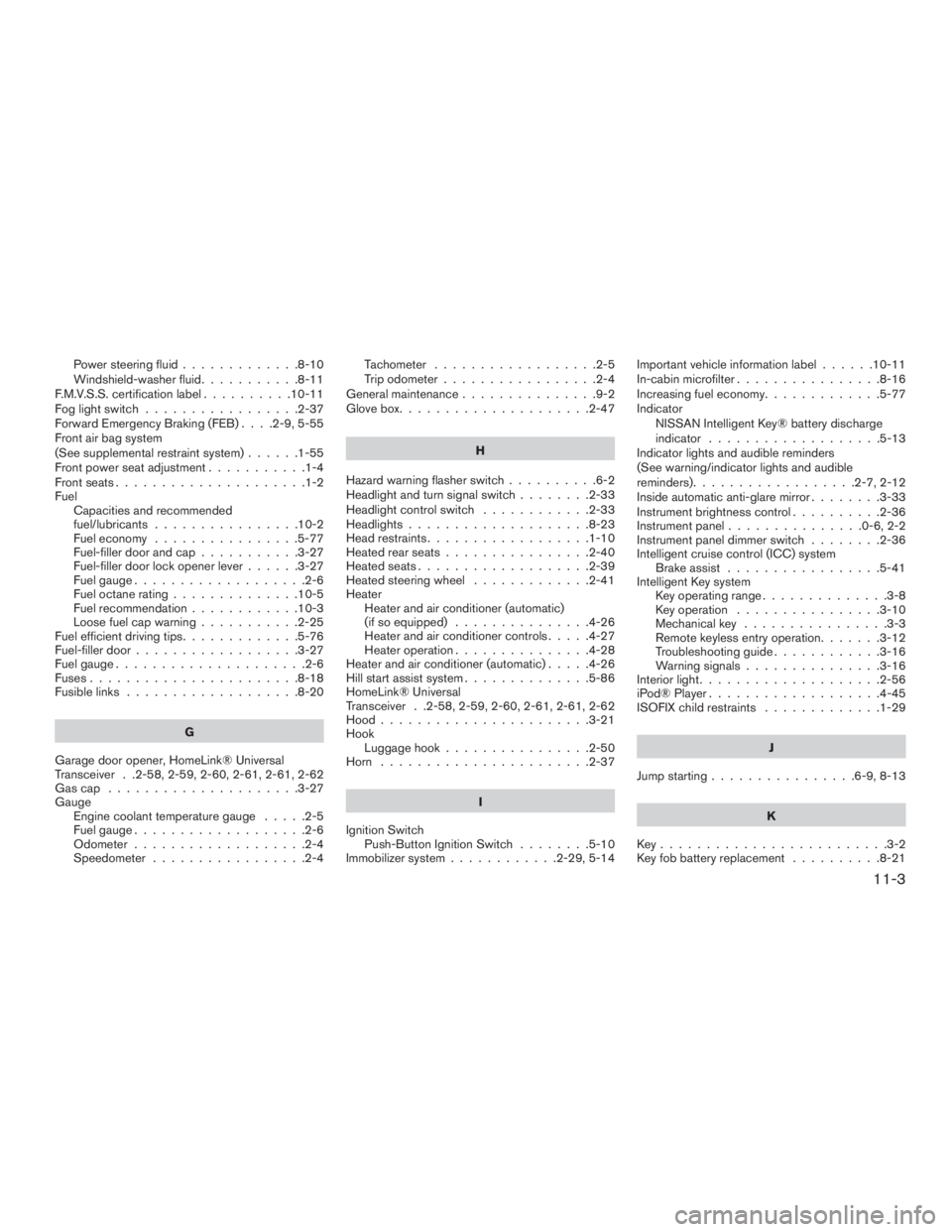Page 330 of 466

WARNING
Failure to follow the warnings and instruc-
tions for proper use of the Driver Attention
Alert system could result in serious injury
or death.
●The Driver Attention Alert system is only
a warning to inform the driver of a po-
tential lack of driver attention or
drowsiness. It will not steer the vehicle
or prevent loss of control.
● The Driver Attention Alert system does
not detect and provide an alert of the
driver’s lack of attention or fatigue in
every situation.
● It is the driver’s responsibility to:
– Stay alert,
– Drive safely,
– Keep the vehicle in the traveling lane,
– Be in control of the vehicle at all times,
– Avoid driving when tired,
– Avoid distractions (texting, etc) .
The Driver Attention Alert system helps alert the
driver if the system detects a lack of attention or
driving fatigue. The system monitors driving style and steering
behavior over a period of time, and it detects
changes from the normal pattern. If the system
detects that driver attention is decreasing over a
period of time, the system uses audible and visual
warnings to suggest that the driver take a break.
DRIVER ATTENTION ALERT SYSTEM
OPERATION
If the system detects driver fatigue or that driver
attention is decreasing, the message “Take a
break?” appears in the vehicle information display
and a chime sounds when the vehicle is driven at
speeds above 37 mph (60 km/h).
The system continuously monitors driver atten-
tion and can provide multiple warnings per trip.
The system resets and starts reassessing driving
style and steering behavior when the ignition
switch is cycled from on to off and back on.
Page 337 of 466

WARNING
●Do not stop or park the vehicle over
flammable materials such as dry grass,
waste paper or rags. They may ignite
and cause a fire.
● Safe parking procedures require that
both the parking brake be set and the
transmission placed into P (Park) . Fail-
ure to do so could cause the vehicle to
move unexpectedly or roll away and re-
sult in an accident. Make sure the shift
lever has been pushed as far forward as
it can go and cannot be moved without
depressing the foot brake pedal. ●
Never leave the engine running while
the vehicle is unattended.
● To help avoid risk of injury or death
through unintended operation of the
vehicle and/or its systems, do not leave
children, people who require the assis-
tance of others or pets unattended in
your vehicle. Additionally, the tempera-
ture inside a closed vehicle on a warm
day can quickly become high enough to
cause a significant risk of injury or
death to people and pets. 1. Firmly apply the parking brake.
2. Move the shift lever to the P (Park) position.
3. To help prevent the vehicle from rolling into
traffic when parked on an incline, it is a good
practice to turn the wheels as illustrated.
● HEADED DOWNHILL WITH CURB
�A:
Turn the wheels into the curb and move the
vehicle forward until the curb side wheel
gently touches the curb.
● HEADED UPHILL WITH CURB
�B:
Turn the wheels away from the curb and
move the vehicle back until the curb side
wheel gently touches the curb.
● HEADED UPHILL OR DOWNHILL, NO
CURB
�C:
Turn the wheels toward the side of the road
so the vehicle will move away from the cen-
ter of the road if it moves.
4. Place the ignition switch in the LOCK posi- tion.
Page 384 of 466
WARNING
Be sure the engine and ignition switch are
off and that the parking brake is engaged
securely.
Page 456 of 466

Power steering fluid.............8-10
Windshield-washerfluid...........8-11
F.M.V.S.S. certification label ..........10-11
Foglightswitch .................2-37
Forward Emergency Braking (FEB) ....2-9,5-55
Front air bag system
(See supplemental restraint system) ......1-55
Front power seat adjustment ...........1-4
Frontseats.....................1-2
Fuel Capacities and recommended
fuel/lubricants ................10-2
Fuel economy ................5-77
Fuel-filler door and cap ...........3-27
Fuel-filler door lock opener lever ......3-27
Fuel gauge ...................2-6
Fuel octane rating ..............10-5
Fuel recommendation ............10-3
Loose fuel cap warning ...........2-25
Fuel efficient driving tips .............5-76
Fuel-filler door ..................3-27
Fuel gauge .....................2-6
Fuses.......................8-18
Fusible links ...................8-20
G
Garage door opener, HomeLink® Universal
Transceiver . .2-58, 2-59, 2-60, 2-61, 2-61, 2-62
Gascap .....................3-27
Gauge Engine coolant temperature gauge .....2-5
Fuel gauge ...................2-6
Odometer ...................2-4
Speedometer .................2-4 Tachometer
..................2-5
Trip odometer .................2-4
General maintenance ...............9-2
Glovebox.....................2-47
H
Hazard warning flasher switch ..........6-2
Headlight and turn signal switch ........2-33
Headlight control switch ............2-33
Headlights ....................8-23
Head restraints ..................1-10
Heated rear seats ................2-40
Heated seats ...................2-39
Heated steering wheel .............2-41
Heater Heater and air conditioner (automatic)
(if so equipped) ...............4-26
Heater and air conditioner controls .....4-27
Heater operation ...............4-28
Heater and air conditioner (automatic) .....4-26
Hill start assist system ..............5-86
HomeLink® Universal
Transceiver . .2-58, 2-59, 2-60, 2-61, 2-61, 2-62
Hood .......................3-21
Hook Luggage hook ................2-50
Horn .......................2-37
I
Ignition Switch Push-Button Ignition Switch ........5-10
Immobilizer system ............2-29,5-14 Important vehicle information label
......10-11
In-cabin microfilter ................8-16
Increasing fuel economy .............5-77
Indicator NISSAN
Intelligent Key® battery discharge
indicator ...................5-13
Indicator lights and audible reminders
(See warning/indicator lights and audible
reminders)..................2-7,2-12
Inside automatic anti-glare mirror ........3-33
Instrument brightness control ..........2-36
Instrumentpanel...............0-6,2-2
Instrument panel dimmer switch ........2-36
Intelligent cruise control (ICC) system Brake assist .................5-41
Intelligent Key system Key operating range ..............3-8
Key operation ................3-10
Mechanical key ................3-3
Remote keyless entry operation.......3-12
Troubleshooting guide ............3-16
Warning signals ...............3-16
Interior light ....................2-56
iPod®Player...................4-45
ISOFIX child restraints .............1-29
J
Jump starting ................6-9,8-13
K
Key.........................3-2
Key fob battery replacement ..........8-21
11-3
Page:
< prev 1-8 9-16 17-24